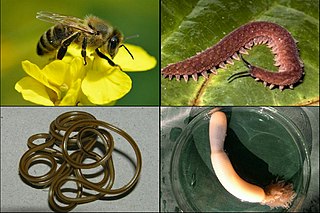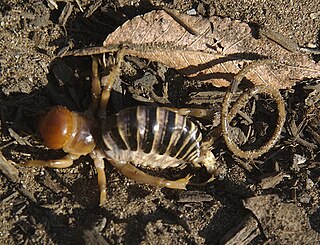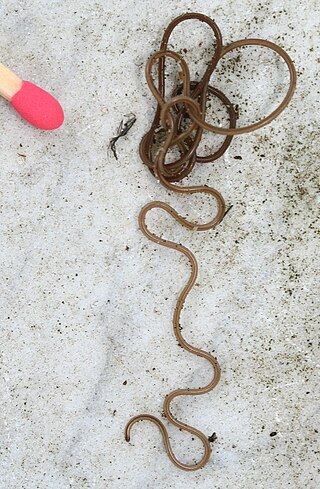
Nematomorpha are a phylum of parasitoid animals superficially similar to nematode worms in morphology, hence the name. Most species range in size from 50 to 100 millimetres, reaching 2 metres (79 in) in extreme cases, and 1 to 3 millimetres in diameter. Horsehair worms can be discovered in damp areas, such as watering troughs, swimming pools, streams, puddles, and cisterns. The adult worms are free-living, but the larvae are parasitic on arthropods, such as beetles, cockroaches, mantises, orthopterans, and crustaceans. About 351 freshwater species are known and a conservative estimate suggests that there may be about 2000 freshwater species worldwide. The name "Gordian" stems from the legendary Gordian knot. This relates to the fact that nematomorphs often coil themselves in tight balls that resemble knots.

Priapulida, sometimes referred to as penis worms, is a phylum of unsegmented marine worms. The name of the phylum relates to the Greek god of fertility, because their general shape and their extensible spiny introvert (eversible) proboscis may resemble the shape of a human penis. They live in the mud and in comparatively shallow waters up to 90 metres (295 ft) deep. Some species show a remarkable tolerance for hydrogen sulfide, anoxia and low salinity. Halicryptus spinulosus appears to prefer brackish shallow waters. They can be quite abundant in some areas. In an Alaskan bay as many as 85 adult individuals of Priapulus caudatus per square meter has been recorded, while the density of its larvae can be as high as 58,000 per square meter.

Ecdysozoa is a group of protostome animals, including Arthropoda, Nematoda, and several smaller phyla. The grouping of these animal phyla into a single clade was first proposed by Eernisse et al. (1992) based on a phylogenetic analysis of 141 morphological characters of ultrastructural and embryological phenotypes. This clade, that is, a group consisting of a common ancestor and all its descendants, was formally named by Aguinaldo et al. in 1997, based mainly on phylogenetic trees constructed using 18S ribosomal RNA genes.

The nematodes, roundworms or eelworms constitute the phylum Nematoda. They are a diverse animal phylum inhabiting a broad range of environments. Most species are free-living, feeding on microorganisms, but there are many that are parasitic. The parasitic worms (helminths) are the cause of soil-transmitted helminthiases.
Tubiluchidae is one of the two families of priapulimorphidan priapulid worms.

Gordius is a genus of worms in the phylum Nematomorpha, the horsehair worms. It was formerly treated as the only genus in the family Gordiidae, but the genus Acutogordius is now considered as distinct. The genus is distributed worldwide except for Antarctica, where no Nematomorpha have been recorded.

Paragordius varius is a parasite species in the horsehair worm group (Nematomorpha). They cycle between terrestrial and aquatic habitats and are most commonly known for their ability to manipulate their definitive host to jump into a pool of water, which allows them to complete their life cycle. Adults are over 10 cm long and 400 μm in diameter. P. varius is usually found in water or wet areas. The definitive hosts are mainly terrestrial arthropods, most often carabid beetles, crickets and praying mantids.

Priapulidae is the canonical family of priapulid worms, comprising Priapulus and Priapulosis as well as the Carboniferous genus Priapulites.
Nectonema is a genus of marine horsehair worms first described by Addison E. Verrill in 1879. It is the only genus in the family Nectonematidae described by Henry B. Ward in 1892, in the order Nectonematoidea, and in the class Nectonematoida. The genus contains five species; all species have a parasitic larval stage inhabiting crustacean hosts and a free-living adult stage that swims in open water.

Gordiidae is a family of parasitic horsehair worms belonging to the order Gordioidea.

Chordodidae is a family of parasitic horsehair worms belonging to the order Gordioidea; its taxonomy is under review.

Gordionus is a genus of Nematomorpha belonging to the family Chordodidae.
Euchordodes is a genus of worms belonging to the family Chordodidae.

Paragordionus is a genus of worms belonging to the family Chordodidae.
Semigordionus is a genus of worms belonging to the family Chordodidae This genus is associated with freshwater habitats.

Paragordius is a genus of worms belonging to the family Chordodidae. It was independently described by both Lorenzo Camerano in 1897 and Thomas Harrison Montgomery Jr. in 1898, though both authors gave the genus the same name.
Gordius balticus is a species of horsehair worm belonging to the genus Gordius.

Acutogordius is a genus of worms belonging to the family Gordiidae.
Beatogordius is a genus of worms belonging to the family Chordodidae.

Methana marginalis, also known as the common methana and the bush cockroach, is a species of cockroach native to the Queensland coast of Australia. The species was first described as Periplaneta marginalis by Henri Louis Frédéric de Saussure in 1864. The species was introduced to Norfolk Island in the mid-to-late 20th century, and in the 21st century has increasingly been seen in the southeastern Australia.













